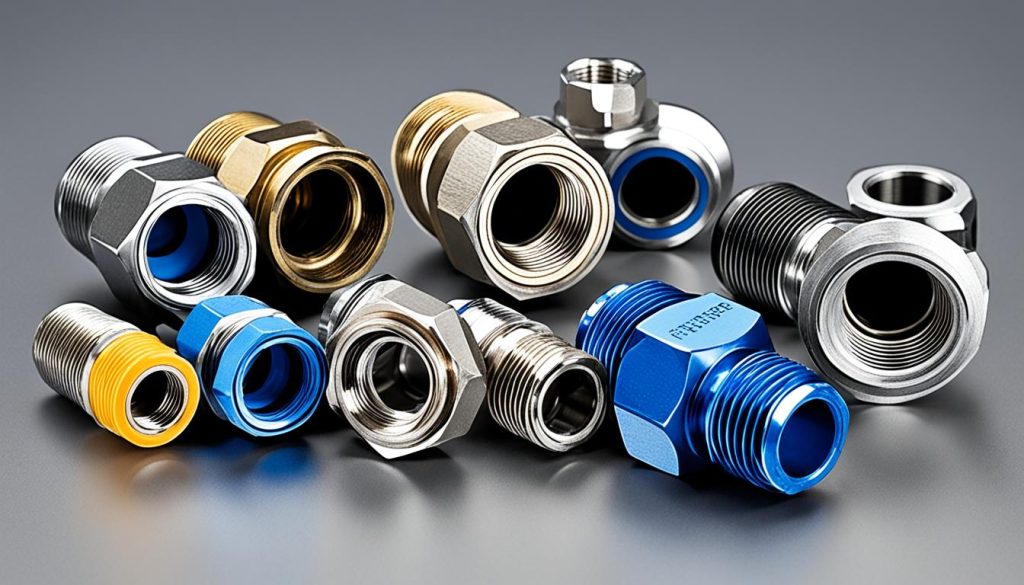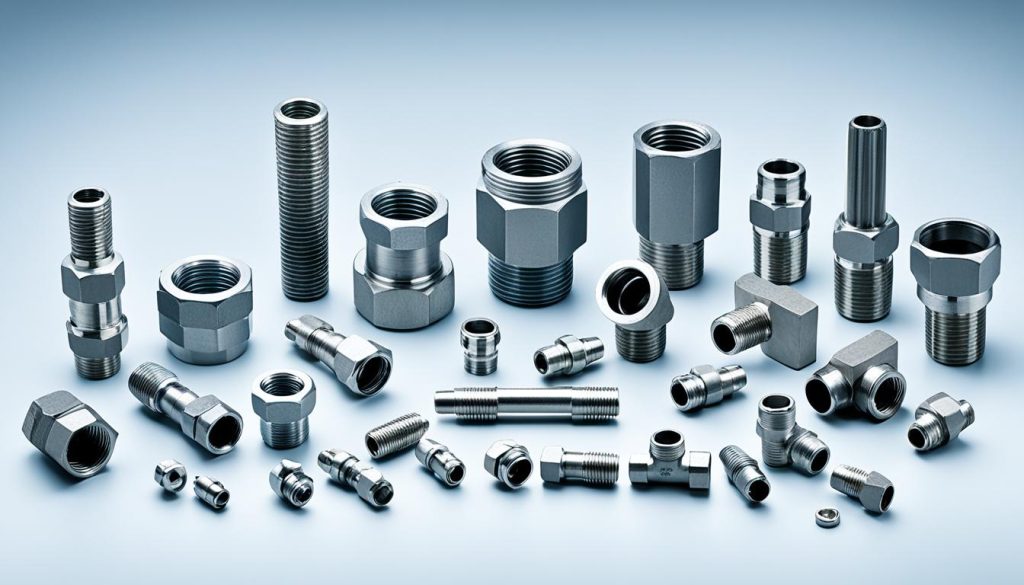Exploring NPT Fittings: Thread Types & Uses
Did you know that NPT fittings are used in a wide range of industries, including oil and gas, manufacturing, automotive, plumbing, construction, and agriculture? These fittings play a crucial role in creating secure and leak-free connections in piping systems, ensuring efficient fluid flow and preventing costly leaks.
Key Takeaways:
- NPT fittings, also known as National Pipe Taper fittings, have tapered threads that allow for a tight seal when twisted together.
- Thread sealants like Teflon tape or liquid are essential to ensure a pressure-tight seal in NPT fittings.
- NPT fittings come in various sizes and are commonly used in hydraulic systems, pneumatic devices, cooling systems, and fuel and brake systems.
- The unique tapered thread design of NPT fittings provides a more secure fit and better sealing compared to parallel threads.
- Made from materials like brass, stainless steel, steel, and plastic, NPT fittings offer different properties such as strength, durability, and corrosion resistance.
Understanding NPT Fittings and Their Design
The unique design of NPT fittings sets them apart from other types of fittings. The tapered thread design allows for a more secure fit and a better seal. Unlike parallel threads, NPT threads taper off, narrowing towards the end of the fitting, which creates a tighter connection.
However, to ensure a leak-proof seal, the use of thread sealants is recommended. Thread sealants, such as PTFE tape or pipe joint compounds, fill in the minute spaces between the threads and lubricate them to prevent leakage and galling.
The choice of material for NPT fittings depends on the application’s requirements. Common materials include brass, stainless steel, steel, and plastic. Each material has its own properties, such as strength, durability, corrosion resistance, and suitability for different fluids.
In summary, NPT fittings have a unique tapered thread design that ensures a secure fit and a reliable seal. The use of thread sealants further enhances their performance. Additionally, selecting the appropriate material for NPT fittings is crucial to meet the specific demands of the application.
Types of NPT Fittings and Their Applications
NPT fittings are available in various types, each serving specific purposes in different industries. Understanding the different types of NPT fittings can help you choose the right fit for your application.
1. Male NPT Fittings
Male NPT fittings have external threads that connect to the internal threads of other fittings. They are commonly used to extend lines or connect pipes and hoses together. The male NPT fittings provide a secure and leak-free connection.
2. Female NPT Fittings
Female NPT fittings have internal threads that receive the male NPT fittings. They are designed to create a tight seal when connected, preventing any leakage. Female NPT fittings are commonly used in plumbing systems and fluid transfer applications.
3. NPTF Fittings (National Pipe Thread Fuel)
NPTF fittings, also known as Dryseal American National Standard Taper Pipe Thread, provide an enhanced level of sealing compared to standard NPT fittings. These fittings have additional crests and roots on the threads, which improve the sealing efficiency. NPTF fittings are commonly used in high-pressure applications that require a reliable and leak-free connection.
NPT fittings find applications in various industries, including:
- Oil and gas
- Manufacturing
- Automotive
- Plumbing
- Construction
- Marine
- Agriculture
- Food and beverage
These versatile fittings are used in a wide range of systems and equipment, including:
- Hydraulic systems
- Pneumatic devices
- Cooling systems
- Fuel and brake systems
- Plumbing and HVAC systems
- And more
With their reliable and adaptable design, NPT fittings provide a crucial component for secure connections in various industries and applications.
Exploring Different Connection Types
When it comes to piping systems, there are various connection types available, each with its own benefits and applications. In this section, we will delve into the different connection types commonly used in the industry.
Threaded Connections
Threaded connections, such as NPT fittings, are widely used for their secure fit and reliable performance. These connections feature tapered threads that create a tight seal when twisted together. The threaded design ensures a sturdy connection that can withstand pressure and prevent leakage.
Barbed or Insert Connections
Barbed or insert connections are particularly useful for joining tubing securely. To create these connections, barbs are inserted into the tubing, providing a secure grip and preventing accidental disconnection. Barbed or insert connections are commonly used in applications where a tight seal and resistance to vibration are important.
Push-fit Connections
Push-fit connections, also known as quick-connect fittings, are renowned for their ease of use and convenience. With these fittings, assembly and disassembly are a breeze—simply push the tubing into the fitting to create a secure connection. Push-fit connections are popular for applications that require frequent maintenance or modification, as they allow for quick and easy changes.
Compression Connections
Compression connections are a reliable choice when it comes to joining tubing together. These connections utilize compression fittings and sleeves, which are tightened to create a tight seal. Compression connections are commonly used in plumbing systems and applications where leak-free connections are essential.
Other connection types include twist and lock, plastic quick connect, flare, garden hose, solder/copper, and crimp/cold expansion. Each of these connection types has its own unique advantages and specific applications, providing flexibility and versatility for various piping needs.
By understanding the different connection types available, you can choose the most suitable option for your specific application, ensuring a secure and efficient piping system.
Applications and Industries that Rely on NPT Fittings
NPT fittings play a crucial role in various industries that heavily rely on efficient and reliable piping systems. In the oil and gas industry, NPT fittings are extensively used in drilling rigs, refineries, and in the transportation of materials under high pressure. The manufacturing industry relies on NPT fittings in hydraulic systems, pneumatic devices, and cooling systems to ensure smooth operations and optimal performance.
The automotive industry depends on NPT fittings for their fuel and brake systems, where secure and leak-free connections are of utmost importance. In plumbing and HVAC systems, NPT fittings enable the efficient flow of water and gas, ensuring the seamless operation of these vital systems. Construction companies utilize NPT fittings in heavy-duty equipment such as bulldozers, backhoes, and cranes to maintain the structural integrity and safety of their machinery.
The marine industry relies on NPT fittings for the plumbing systems of boats and ships, guaranteeing a watertight seal and preventing leaks. In the agriculture sector, NPT fittings are widely used in irrigation systems to efficiently deliver water to crops, ensuring proper hydration and optimal growth. Additionally, NPT fittings are indispensable in the food and beverage industry. They are used in breweries, distilleries, food processing plants, and more, where leak-resistant connections are essential to maintain the safety and quality of products.
Source Links
- https://blog.boshart.com/ultimate-overview-of-connection-types-pictures-included
- https://hosebox.com/insights/npt-fittings-a-comprehensive-guide/
- https://www.cpcworldwide.com/Resources-Support/Technical-Toolbox/Understanding-NPT-Pipe-Thread-Types
- Investing Wisely: How Windows & Doors in Boost Property Value and Financial Health - April 24, 2025
- The Financial Impact of Personal Injuries: Why Legal Help Matters for Business Owners - April 16, 2025
- The Hidden Financial Costs of Domestic Assault: What Business Owners Need to Know - April 16, 2025













